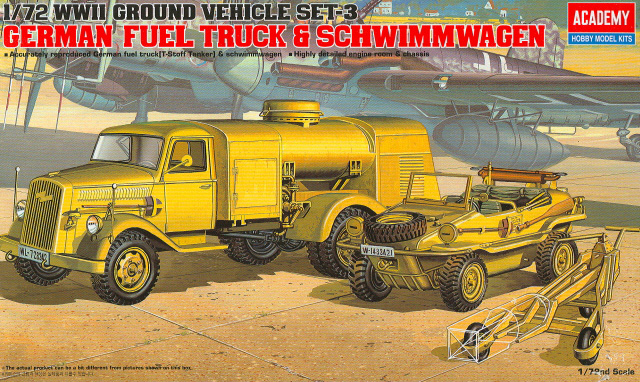Academy 1/72 Scale Kit No. 13401;
1/72 WWI Ground Vehicle Set 3, German Fuel Truck & Schwimmwagen
by Cookie Sewell

26 parts (117 in tan styrene, 9 in clear styrene); price US $19.
Advantages: another nice "dual purpose" kit from Academy; bomb
trolley a handy item; state-of-the-art kit will be appreciated.
Disadvantages: may be viewed as "too aircraft" by armor modelers
or "too armor" by aircraft modelers.
Rating: Highly Recommended.
Recommendation: For all German WWII ground AND air "small scalers"
I recall as a kid reading a book on the RAF that discussed the "sinews
of war" or what it took to get things done. Surprisingly it covered
little of the support equipment needed to get the job done.
The first inklings of support vehicle equipment showed up in the mid
1960s when Airfix did three nice kits of RAF support equipment –
"petrol bowsers," ambulances, cranes, and recovery vehicles,
albeit in 1/76 they had to be "fudged" to fit in with 1/72 aircraft.
In the early 1970s Hasegawa provided a Hucks starter and fuel tanker for
Japanese aircraft in proper 1/72 scale. But other than a few odds and
ends, such as the items thrown in with aircraft kits as a "bonus,"
few dedicated kits were released.
Academy now is continuing with its line of 1/72 WWII Ground Vehicles,
primarily designed to complement aircraft models, but which can also be
used with 1/72 armor. The first two were a Jeep/Kubelwagen double kit
and a very nice US GMC CCKW. This third member of the series, providing
a VW Typ 166 Schwimmwagern and an Opel Blitz 4 x 2 3.6 liter configured
as a fuel tanker. Also included is a bomb transport and lifting trolley.
The kits are quite detailed, with the Schwimmwagen appearing to be nearly
as complex as the original 1/35 scale Tamiya kit from the early 1970s.
All of the interior parts are separate, to include a shifter and parking
brake handle, and the modeler is given an option on windshields as well
– two-piece (clear insert and tan frame) or a one-piece with integral
frame (e.g. mask to paint.) It comes with a paddle and eight "jerry"
cans as accessories, but the handles on the cans are one piece so the
modeler wishing greater detail will have to separate them into three distinct
bars (a file or saw and a few minutes each should work.)
The Blitz is a standard chassis, as Academy have already indicated more
ground-oriented items will coming such as cargo and troop transport versions.
The chassis is, like that of the GMC, quite detailed with all of the springs
and the drive shaft as separate parts. The kit also provides a nice engine
block and transmission with a separate fan and generator assembly, but
then as with the GMC provide no way to see it once assembled. The panels
on the sides of the hood will have to be cut off before assembly if the
modeler wants to provide a "field service" type of vehicle,
especially in a North African setting.
The cab comes with all basic details and a full set of offset (e.g. flush
exterior when installed) clear windows. With some care the doors may be
cut out and repositioned in the open position, but the kit does not give
a great deal of provision for that other than the separation line for
the door from the body on the inside of the parts. Headlight lenses are
also separate clear parts, and to their credit, for the fumble-fingered
among us they provide three with the kit. (It also immediately permits
the installation of MV Lenses of suitable size without drilling, a benefit
in this scale.)
The tanker body comes with a number of diorama-friendly options, such
as separate lids for the service lockers forward and separate rear doors
for access to the pump assembly. No hoses or hose material is provided,
however.
Decals are provided for only Luftwaffe vehicles, alas, so the modeler
is on his own to come up with other branches of service markings. As the
tanker is a semi-tactical vehicle (the 4 x 2 types are not as viable off
road or in nasty conditions such as Russia) it is probably just as well.
Overall, the vehicles are nicely done and appealing, and Academy may
have found a good way to "walk the line" between armor and aircraft
modelers.
Thanks to Bob Lewen of MRC for the review sample.
Cookie Sewell
|